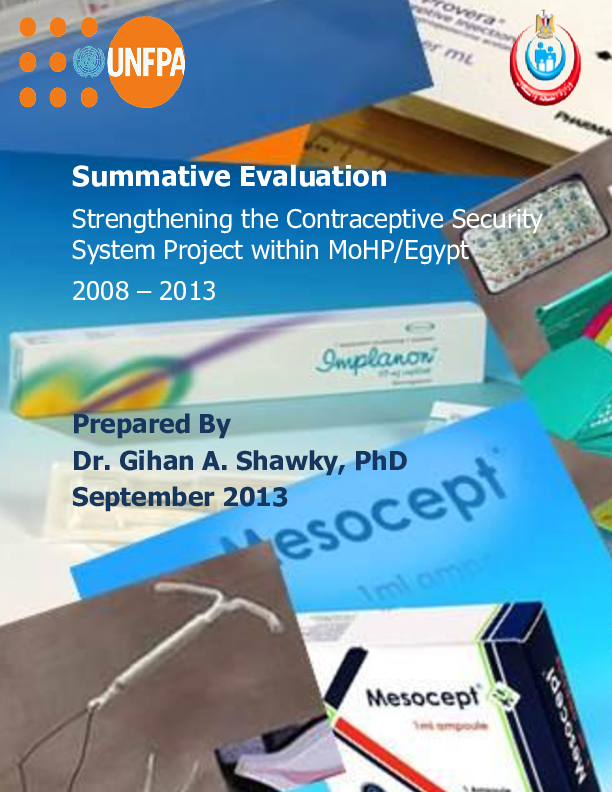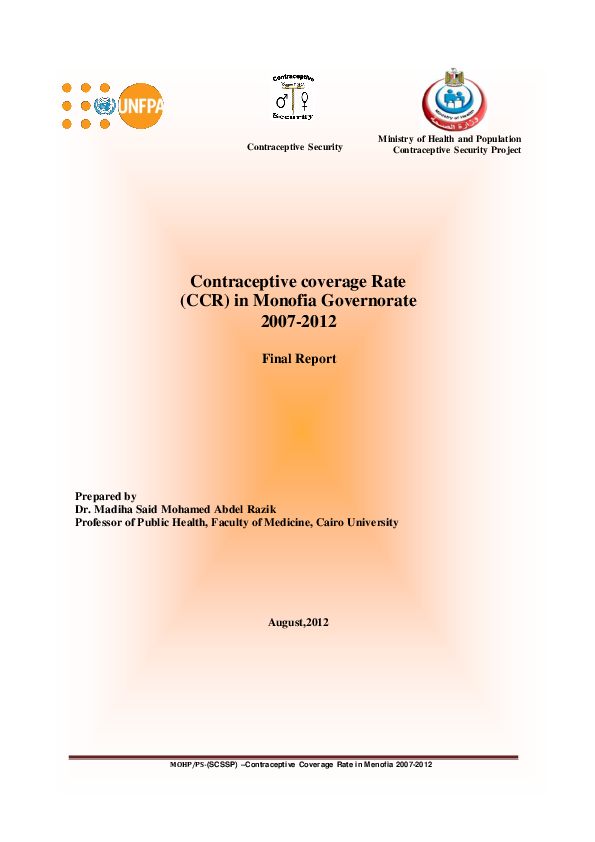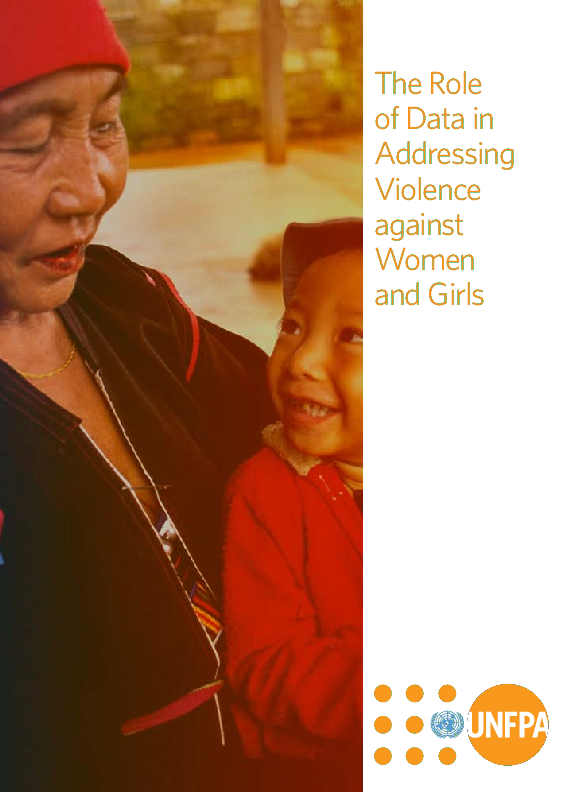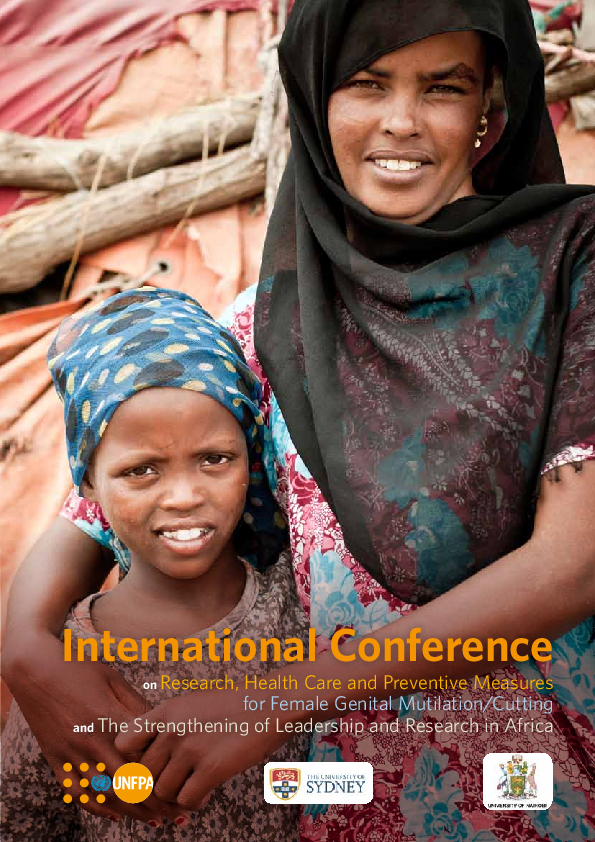You are here
New Releases
Baseline Assessment of the Public Health System Management at District Level in Assiut and Sohag, Egypt
The Egyptian government is currently partnering with the United Nations Population Fund Egypt Country Office in order to introduce effective interventions on the administrative aspect of healthcare in the areas that need it the most. As part of the ongoing efforts, this study was conducted to assess the robustness of both the monitoring and evaluation (M&E) of primary healthcare services, and the health information system (HIS) at the level of health districts of the public healthcare sector. It was conducted in Assiut and Sohag governorates, two of the governorates with poorest villages, and highest mortality rates and ratios.

Summative Evaluation - Strengthening the Contraceptive Security System Project within MOHP Egypt, 2008-2013
The UNFPA Egypt country office, as part of its assistance to the Government of Egypt is supporting the project titled ‗Strengthening the Contraceptive Security System‘ within Ministry of Health-Family Planning & Population Sector. The project targets the various pillars of CS, from commitment and coordination to policies and service delivery. It aims also to build the national capacity both at the central and local levels on logistics functions, logistics data & product selection. The project budget is 4.9 million Egyptian Pounds.

CPAP Jul 2013-Dec 2017
The Basic Agreement concluded between the Government and the United Nations Development Programme on 19 January 1987(the “Basic Agreement”) mutatis mutandis applies to the activities and personnel of UNFPA in Egypt. This CPAP together with any work plan concluded hereunder, which shall form part of this CPAP and is incorporated herein by reference, constitutes the project document as referred to in the Basic Agreement. References in the Basic Agreement to “Executing Agency” shall be deemed to refer to “Implementing Partner” as such term is defined in the Financial Regulations of UNFPA and used in this CPAP and any work plans concluded hereunder

Reasons for Shift from IUDs to Oral Contraceptives among MOHP Clients, 2007-2012
EXECUTIVE SUMMARY
There is evidence that the MDGs will not be achieved unless there is universal access to quality reproductive health services especially FP. Each country should address the different challenges to FP programs especially those related to unmet needs, discontinuation, and method mix to support the MDGs related to reducing maternal morbidity and mortality. In Egypt, the contraceptive coverage rate had shown a decrease from 53.4% in 2007 to 45% in 2011. Additionally, the method mix had shown different profile in 2011 compared with that in 2007. According to MOHP/PS service statistics there was increase in FP clients by 39% in 2011 compared with 2007.

Implanon Use Pattern among Ministry of Health and Population Clients 2008-2012
Introduction
Egypt current family planning program strategies depend on the voluntary FP method use that requires sustainable activities for demand creation for FP methods. The financial strategy of FP program relies on the public investment approach, as the GOE is the prime financier of FP methods and services. In almost of the countries that reached to plateau in FP method use, and aiming at sustainability and success of FP program, the most substantial interventions should be directed to respond to unmet needs for FP. The introduction of IMPLANON in Egypt FP program was aiming at responding to women’s needs for safe and effective FP method with less side effects as well as fulfillment of social, cultural and financial acceptability.

Research on Contraceptive Security, prepared by Dr. Madiha Said Abdel Razik
Introduction
Throughout the period 2002-2011 the family planning program underwent different challenges resulted in increase in the crude birth rate from 25.5 live births /1000 population in 2005 to 27.9 live births per 1000 population in 2010. According to EDHS 2005 – 2008, the contraceptive prevalence rate (CPR) for all methods was 59. 2% in 2005 and 60.3% in 2008 and for modern methods CPR were 56.5% in 2005 and 57.6% in 2008. Unmet needs for FP is maintained at high level i.e. 10.3% in 2005 and 9.2% in 2008. According to National Population Council, the Contraceptive Coverage Rate (CCR) is used as proxy indicator for monitoring the contraceptive prevalence rate (CPR). CCR is the percent of the distributed FP methods (expressed as couple year protection/CYP) to total number of married women in the reproductive age (MWRA). According to NPC statistics CCR at the national level had shown a decrease from 58% in 2005 to 45% in 2011.

UNFPA CPD 2013-2017
Egypt has been in a state of transition, with many cabinet reshuffles and ministerial reorganizations. The political instability has led to economic hardship that continues to hamper development, with a particular impact on the labour market. The unemployment rate in 2012 was 12.6 per cent. However, the rate was higher among women (24.1 per cent) than men (9.2 per cent). The unemployment rate among young people aged 15-24 is 30 per cent.

The Role of Data in Addressing Violence against Women and Girls
As the global spotlight has turned more sharply over the last decade on the persistence of violence against women and girls, the need for more and better data to inform evidence-based programming in order to address this human rights violation has escalated.

Marrying Too Young ... End Child Marriage
This report is a clarion call to decision makers, parents, communities and to the world to end child marriage. It documents the current scope, prevalence and inequities associated with child marriage and highlights that by 2020, Some 142 million girls will be married by their 18th birthday if current trends continue. This translates into 14.2 million girls married each year, or 37,000 girls married each day. Child marriage jeopardizes girls’ rights and stands in the way of girls living educated, healthy and productive lives. It also excludes girls from fundamental decisions, such as the timing of marriage and choice of spouse.

Research, Health Care and Preventive Measures for FGM/C and the Strengthening of Leadership and Research in Africa
The conference documented in this report gave those working across a range of fields towards ending female genital mutilation/cutting a chance to share their experiences. Many participants indicated that it crucial for those in African countries to work more closely with those from other regions and countries to share and learn from one another’s efforts. Participants also explored the possibility of establishing an African Coordinating Centre for the Elimination of FGM/C, as proposed by the University of Nairobi